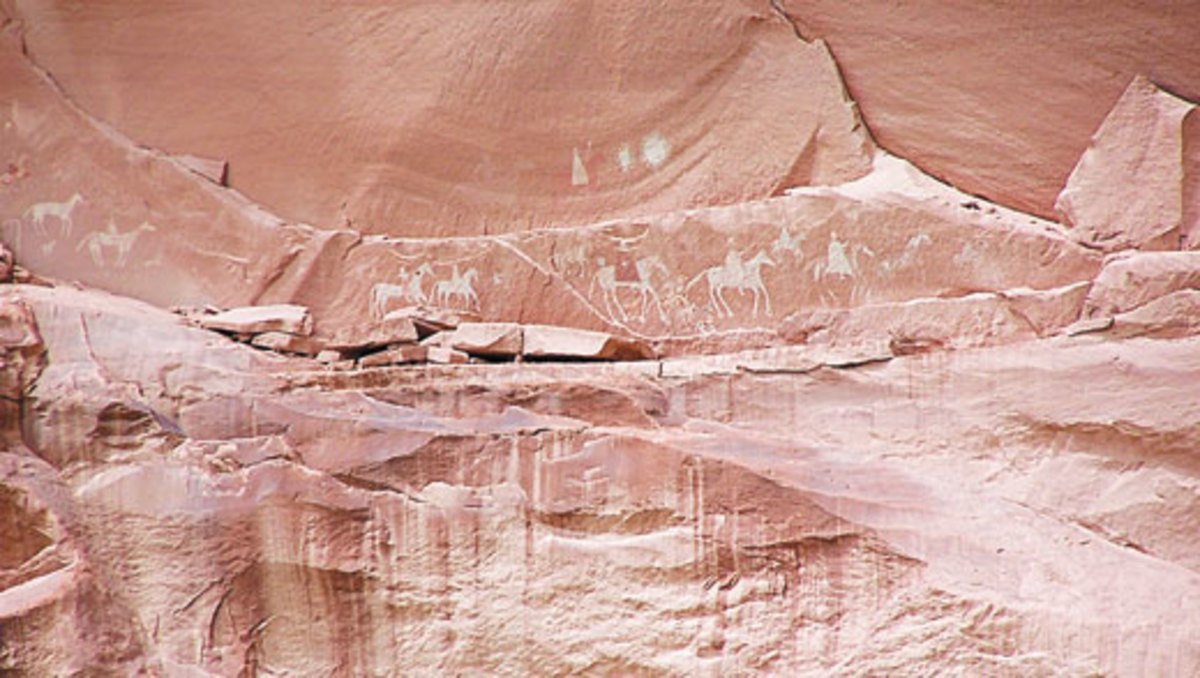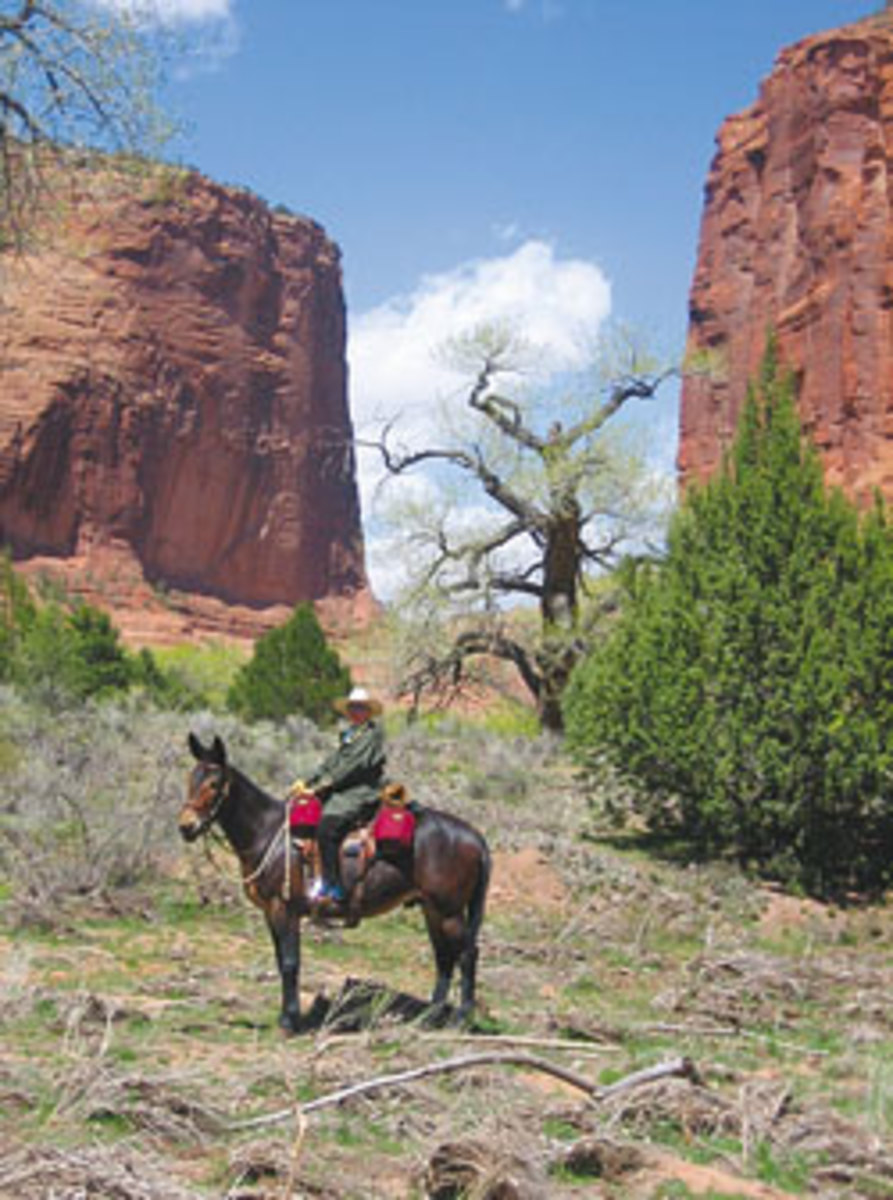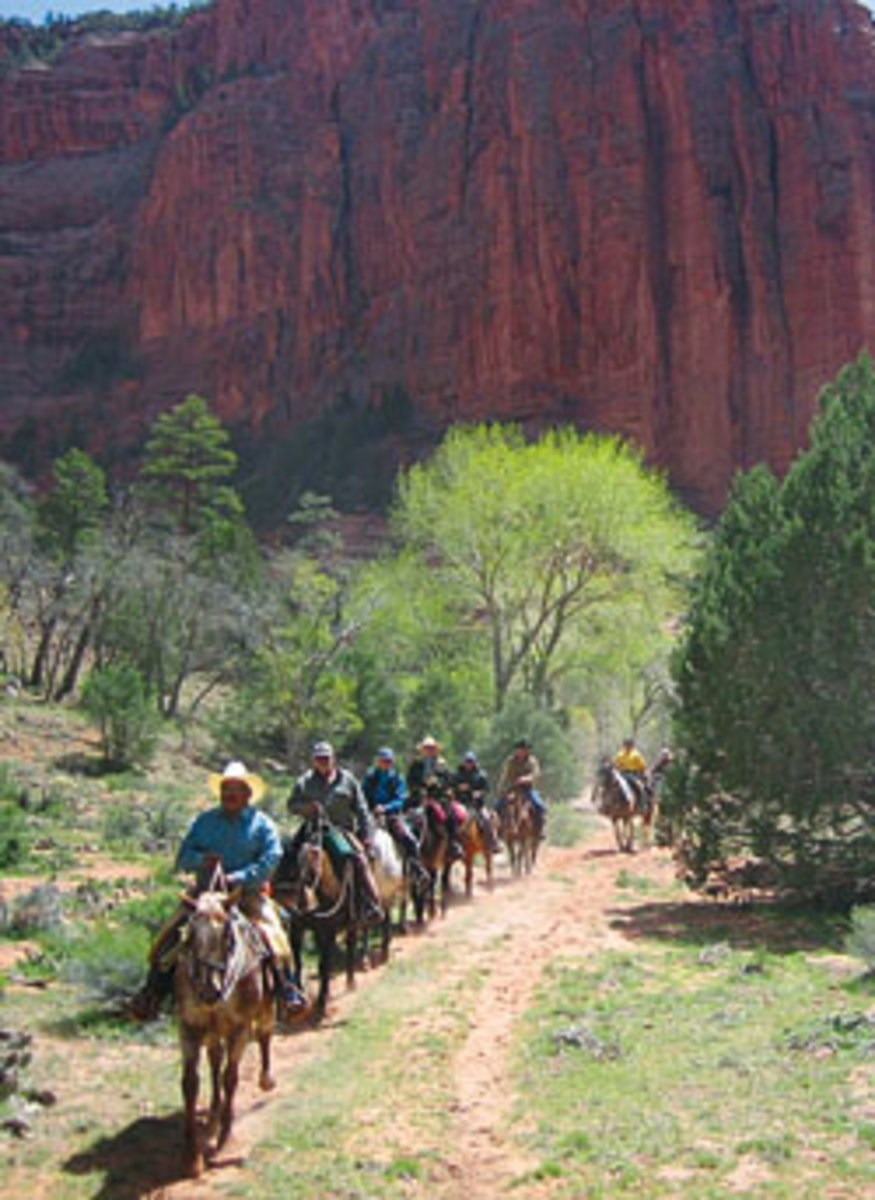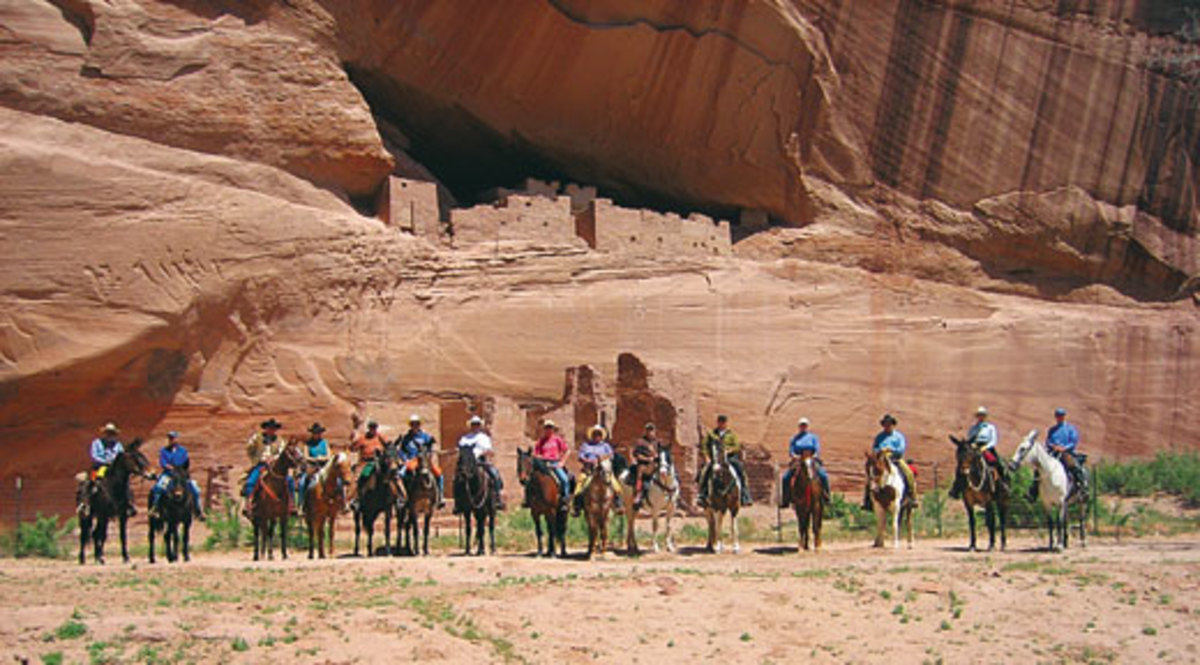
Last April, my family organized an invitational ride for 14 family and friends into Canyon de Chelly (pronounced d’SHAY) National Monument, located in the heart of the Navajo Indian reservation in Northeast Arizona, near Chinle. The labyrinth monument is really made up of three canyons: Canyon de Chelly, Canyon del Muerto, and Monument Canyon.
At the canyon mouth, the rock walls are only 30 feet high. Deeper into the canyon, the walls rise dramatically, until they tower more than 1,000 feet above the floor. Elevation ranges from 5,500 feet at the visitor center to just over 7,000 feet at the last overlook. The network of sandstone passages and beautiful sheer walls served as our backdrop for four full days of riding.
The best time of the year to ride is spring and late fall. In the summer, temperatures can climb to the triple digits; in the winter, the canyon does get snow.
Ancient Heritage
Canyon de Chelly’s physical nature has always had a profound effect on the people who lived there. The canyon has harbored some of the most fascinating and complex Indian cultures in America.
Anasazi (a Navajo word meaning “the ancient ones”) inhabited the canyon for about 600 years, from about 700 to 1300 AD. Evidence of their existence can be seen throughout the canyon: home sites tucked into the canyon walls; pictographs; petroglyphs; and pottery shards strewn about the canyon floor.
The Navajo Nation inhabited these lands beginning in the 1700s. At that time, the canyon soil was fertile, a productive environment for growing corn and orchards.

In 1931, Canyon de Chelly National Monument was established to preserve archeological ruins within the canyon walls and their important record in human history. Embracing 84,000 acres within the Navajo Indian Reservation and comprised entirely of Navajo Tribal Trust Land, the monument is administered by the National Park Service in partnership with the Navajo Nation.
Our Spiritual Journey
All except one in our party brought our own horses. (The monument rents horses to those who don’t have their own.) Canyon de Chelly has strict health requirements for horses and mules. All documents must be submitted to the National Park Service a minimum of two weeks prior to arrival.
Some in our party camped in the Coolidge-Martin Campground, while others stayed in the Thunderbird Lodge close to the Visitor’s Center and across the street from the campground. I admit I stayed in the lodge, where I thoroughly enjoyed a hot shower every night and ate a hearty breakfast every morning.
To enter the monument, you must be accompanied by an authorized Navajo guide. The park requires one guide per 10 riders. James Jr. and Perry Yazzie, who are brothers, were our official guides for several days of canyon exploration. Here’s my account of our journey.
• Day One: Early the first morning, the Yazzies’ mother arrived at camp. We joined hands around the campfire while she said a prayer for a safe journey. The excitement was electric.
We rode out from camp into the canyon mouth. As we rode deeper into the canyon, the sheer cliffs got higher and higher. We rode primarily along a wash, sloshing through water. We moved aside as the Jeep tours occasionally drove by.
Along the way, we stopped at significant archeological sites, and gathered round to hear stories about Navajo culture and Anasazi history from our Navajo guides. We examined pictographs, petroglyphs, and ruins. Our final destination was Standing Cow Ruins where the Navajo etched drawings into the canyon walls depicting the Spaniards’ arrival in the late 1700s. Shortly after lunch, a thunderstorm rolled in. We rode though hail, snow, sleet, booming thunder, and magnificent lightening. Twenty-three miles later, we arrived back at camp.
• Day Two: The second day, we thought we’d take a shorter ride; as it turned out, it was shorter by just six miles. Thankfully, our mounts were calmer. The weather was beautiful, sunny and 72 degrees.
One visible, striking geologic phenomenon within Canyon de Chelly is the “desert varnish,” the long, uneven streamers that stain the vertical walls at almost every turn and view. These dark lines look like wet streaks left by a recent rainstorm, but are actually chemical deposits that have taken several thousand years to accumulate.
Our destination this day was White House ruins, the second largest Anasazi ruins in the canyon. Occupied about 1,000 years ago, it’s the only place in the canyon that visitors can see without a guide – after hiking down from the rim about 500 feet.
We had a great lunch, then perused the small tables that several Navajo families had set up near the ruins to sell their wares. Most of us bought jewelry. Shopping and riding – the perfect day!
After returning to camp, a few of us toured the Visitor Center, then drove along the south rim to see the canyon from various overlooks. The bird’s-eye view of where we’d been riding was spectacular.
That night, we enjoyed special Navajo entertainment. A local tribal park ranger (and storyteller) told Navajo stories, sang traditional songs, played the drum, and treated us to songs on a traditional Native American flute. Our guide’s son and young niece danced for us adorned in traditional costume. Everyone danced around the campfire. It was an enjoyable, interesting end to a fabulous day.

• Day Three: Our rides thus far had been nice and easy. However, sharing the road with truck and Jeep traffic had become distracting. The third day, we left the artificial horsepower behind and enjoyed a day of riding unlike any other. The only evidence of life were the small herds of wild mustangs and haunting cries of ravens.
We trailered to a spot on the canyon rim and snaked our way down Bat Canyon – a side canyon of Canyon de Chelly. What a ride! The canyon walls towered over 1,000 feet, and we experienced very different vegetation and countryside. The washes and sand floor were replaced by Douglas firs and rocky, steep trails.
The main attraction was Spider Rock, an 800-foot spire that rises from the canyon floor at the junction of Canyon de Chelly and Monument Canyon. The rock provided a dramatic backdrop for a much-needed break. (We rode 18 miles that day.)
On our way back, we were whipped by 50-plus miles-per-hour winds. We each rode with one hand on our hat and the other on the reins. Thankfully, I’d worn a bandanna over my face. Those of our group who didn’t sported sand mustaches!
• Day Four: Most of us concluded that previous day’s ride was perhaps the finest day of trail riding we’d ever had, despite the veritable windstorm. And that’s a statement from those who’ve ridden the Grand Canyon, the Rockies, Monument Valley and the Superstition Mountains, among numerous other places. At the end of our final day, I think it ranked a close second.
The fourth day, we trailered to the opposite rim and slowly made our way down a side canyon. The trail was tremendously beautiful and definitely not for beginners. It consisted of narrow, steep switchbacks over slick rock with sheer drop-offs on one side.
In fact, it was so steep that after traveling about 20 yards, the trail behind us seemed to disappear. We couldn’t see the switchbacks in front or behind us. Thankfully, the members of our group with less experienced horses opted out of the ride. The weather was perfect, clear and calm.

Our final destination was Mummy Cave, the largest Anasazi ruins site. In the early 1900s, archeologists discovered three mummies in this cave and confirmed the Anasazi people were only about three feet tall.
That evening, we invited our guides’ families to join us for a barbecue. There was some discussion earlier in the trip about the famous Native American flute player, Travis Terry, who lived in Chinle. Lo and behold, Travis came to our camp and treated us to peaceful, soothing flute music. It was a fitting way to end our time at Canyon de Chelly.
In all, we rode nearly 65 miles in four days. The mysterious canyon was powerful and beautiful. The riding was varied and presented an interesting challenge at times for even our most experienced horse-and-rider teams. What began as a trail-riding adventure with friends and family became a spiritual journey through a mystical land.
For more information on Canyon de Chelly National Monument, call the National Park Service at (928) 674-5500, or visitwww.nps.gov/cach/. For more on the Thunderbird Lodge, call (800) 679-2473, or visitwww.tbirdlodge.com. For more on the Coolidge-Martin Campground, call (928) 550-1311. To reach James Yazzie Jr., call (928) 674-5647.






